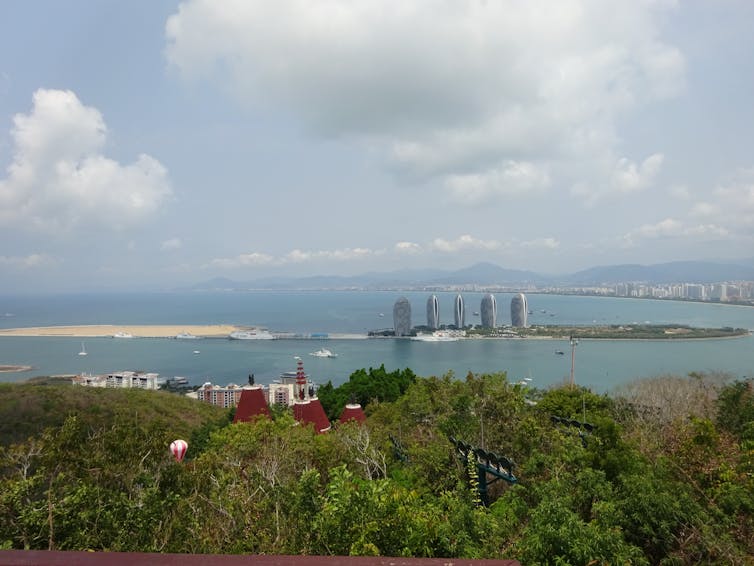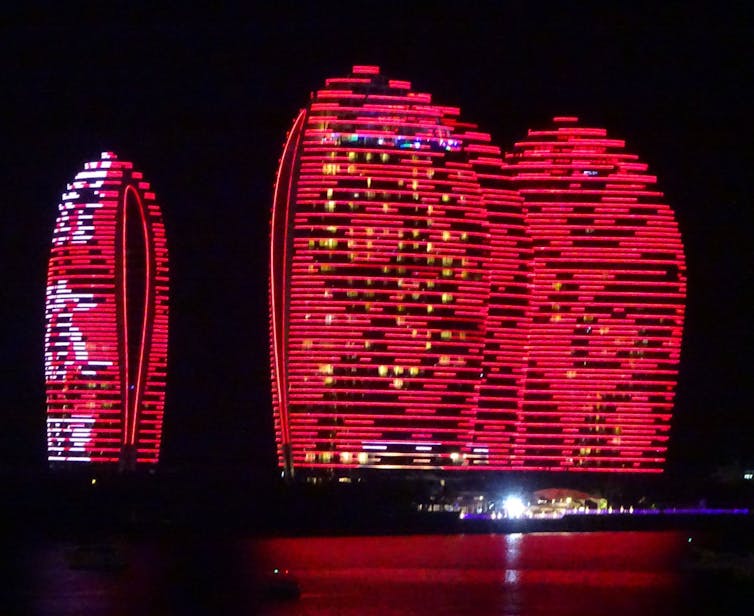Achi news desk-
Dubai’s famous Palm Jumeirah is not the only man-made island that has emerged from the sea this century. Over the past 20 years, many islands have been built to cater for tourists and well-heeled residents – particularly in the Arabian Gulf states and China.
In a time of rising sea levels and increased storm activity, new islands can seem like a risky venture. Yet the desire for a view of the sea and putting blue water between you and the noise, traffic and crime of the mainland keeps the market lively.
Residential artificial islands cater to the rich and have serious environmental consequences. But they are high on big promises. How else to explain the continued expansion of Eko Atlantic, a complex of islands sprouting off coastal Lagos in Nigeria?
Construction companies broke ground on Eko Atlantic’s boulevards and high-rise apartments in 2009. The city government has recently announced five more artificial islands “to open up the city”, and claims that the new islands generate and attract wealth and have already created “30,000 direct new jobs”, mainly in construction and maintenance.
The fashion for island building shows no signs of abating. But instead of answering the desperate need for new housing among people about to be displaced by rising seas, new islands offer something else to distract the wealthy.
How to build an island
As research for my book The Age of Islands, I visited all sorts of new coves that have been reclaimed from the sea. I was amazed at how quickly they can be built. In shallow water, creating an island is not technically complicated: typically, the seabed across a large area is vacuumed up and down, then injected and pumped into a stable foundation.
Alastair Bonnett
In Lagos, the Gulf states and other island-building places like the coast of the Chinese island state of Hainan, developers know that their creations must be protected from the sea. Nigeria has the Great Wall of Lagos, a sea barrier consisting of about 100,000 concrete blocks and rising nine meters above the sea, to protect Eko Atlantic. More modest structures are favored elsewhere, usually in the form of artificial reefs that are dragged and dropped into place, creating a shield against rising seas.
Will any of this be enough? Such barriers provide enough protection long enough to make island building an economic proposition. But this calculation misses something important: all these islands depend on the mainland – that’s where they get their energy, water and food. Lagos is a low-lying city and large parts are at risk of flooding. Eko Atlantic walkways won’t look so chic if they are messed up.
Critics of new islands point to the havoc they wreak on coastal and river systems, changing sediment deposition and erosion patterns and creating silty, warm lagoons that turn living marine environments into dead zones.
This is one of the reasons why the Chinese government intervened to stop the construction of islands around Hainan. From its banks you can see 11 projects, some in full swing, most on hold.

Alastair Bonnett
The world’s largest and most impressive new island, Ocean Flower, can be found here. It is shaped like a lotus with scrolling leaves and is already packed with apartment blocks and amazing architecture, including European-style castles, grand hotels and amusement parks. The plan was to have 28 museums, 58 hotels and the world’s largest conference centre.
Even in the hyperbolic world of island building, it sounds extreme. The developer, Evergrande, is now in financial trouble and 39 residential towers on Ocean Flower have been deemed to have breached environmental and planning regulations and ordered to be demolished.
Cycles of boom and bust seem to plague new islands. But these stories should not mislead us into thinking that this is an industry in decline. The financial incentives remain huge and island makers are an adaptive breed.

Alastair Bonnett
Floating for a while
Floating islands have recently emerged: mooring platforms whose construction does not involve scraping away the seabed, making them less disruptive to the marine environment.
Plans for floating cities keep bubbling up. One hope, Green Float, led by Japanese company Shimz, would be a floating city in the Pacific designed to float on the equator “just like a lily pad” and house 40,000 people.
Building on the high seas will always be challenging, so it’s no surprise that ventures closer to shore, such as the Floating City in the Maldives, are the first to come to fruition. Floating City is a 500-acre development with 5,000 low-rise homes for 20,000 people arranged in a coral-like spread of closely connected islands. The first islands have already been pulled into place.
The plan’s Dutch architect, Koen Olthuis, hopes that the Floating City will not be the preserve of the rich (unlike the others I’ve mentioned). His vision is of ordinary Maldivians, having lost homes and livelihoods to rising seas, finding safe mooring in the Floating City.
But from what I’ve seen, the world of artificial islands caters to the few not the many. Island building is being led by private developers, not environmentalists – or even states. Foreigners are already being encouraged to buy into a Planned City and have been told that this will be their ticket to a Maldivian residency permit. Breaking the bond between wealth and island building will not be easy.

No time to read about climate change as much as you’d like?
Get a weekly digest in your inbox instead. Every Wednesday, The Conversation’s environment editor writes Imagine, a short email that goes a little deeper into just one climate issue. Join the 30,000+ readers who have subscribed so far.

